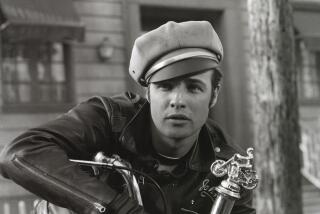IN CIRCULATION : Alexander or Alexandra?
- Share via
Nothing sells a magazine like sex. And when it comes to highbrow literary periodicals, the kinkier the sex the better. Who can forget the “polysexuality” issue of Semio-text(e) (Vol. 4, No. 1, 1981) with its cover photo of a large semi-clad gentleman having carnal knowledge of a Harley-Davidson motorcycle? The issue’s contributors may have been Pierre Klossowoski, Georges Bataille and Alain Robbe-Grillet, but as the subjects these esteemed authors had chosen were voyeurism, sadomasochism and necrophilia, the motorcycle boy was a cover most apropos.
Still, there’s no simple formula when it comes to what W. C. Fields called “dallying in the valley.” Consider Fetishes, the latest issue of Grand Street. The cover shows a sculpture by Yayoi Kusama: a dresser and mirror adorned with what at first appear to be silver cucumbers, but on closer examination reveal themselves to be replicas of that portion of the anatomy dear to the likes of John Wayne Bobbitt. Bob Dole would no doubt declare this image a “nightmare of depravity,” but as “cutting edge” lit-mags go it’s only mildly titillating. And the same might be said of what’s going on inside this special issue.
A piece on piercing “performance artist” Bob Flanagan, for example, is tame compared to his excruciatingly revealing spread in the Modern Primitives issue of RESearch. There’s an amusing but skin-deep interview with writer-director John Waters, whose knowledge of sexual eccentricities is extensive. The photo-essays by Man Ray and Helmut Newton are beautifully reproduced, but not up to the “worst” of Robert Mapplethorpe and Peter-Joel Witkin. The de rigueur Bataille translation is of the far from obscure “Madame Edwards.” But Fetishes is far from a total loss, for on Page 208 you’ll find “The Respectful Fetishist,” in which Alexander Cockburn discusses his life as a transvestite.
That’s right. The left’s most persistent op-ed pit bull apparently enjoys few things more than the “peace and calm” of dressing in women’s attire. “At the age of eleven or so, I loved to sweep downstairs into the drawing room in a long dress,” Cockburn recalls, going on to reveal that he’s taken this pre-adolescent passion up again as an adult: “slipping into J’s dress and adjusting her dear little shoe just so.”
Cockburn never tells us who the mysterious “J” might be, or why he suddenly resumed his cross-dressing ways. Instead we get a few vague mutterings about art history, psychology, religion and Marx’s notion of “commodity fetishism” in that “the gaudy stockings which end up crammed against the schoolboy’s nose represent the congealed labor of the stocking weaver and the exploitative conditions imposed on the stocking weaver by the stocking manufacturer.”
Uh, huh.
Cockburn is clear on one score: whatever you do, don’t mistake him for a member of the “Priscilla Queen of the Desert” crowd. While the article is illustrated with pictures of Cockburn in female attire that look like nothing so much as stills from a remake of “Glen or Glenda?,” he regards them as “representations of the feminine, in contrast to the insulting parodism of drag.”
Perhaps it would be best to leave it to cross-dress professionals, like “Wigstock” stars Jackie Beat and Alexis Arquette, to “read” Cockburn’s efforts. Suffice to say that if his dress-up isn’t a put-on, then the transvestite right may have found its Bruce Bawer.
More to Read
Sign up for our Book Club newsletter
Get the latest news, events and more from the Los Angeles Times Book Club, and help us get L.A. reading and talking.
You may occasionally receive promotional content from the Los Angeles Times.








